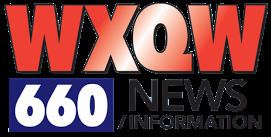Frequency 660 kHz Format Talk | Branding 660 News/Information First air date 1964 (as WMOO) | |
 | ||
Broadcast area | ||
WXQW (660 kHz) is an AM talk radio station licensed to Fairhope, Alabama and serving the Mobile metropolitan area. The station is owned by Cumulus Media and the broadcast license is held by Cumulus Licensing LLC. By day, it broadcasts at 10,000 watts, covering parts of Alabama, Mississippi and the Florida Panhandle. But at night, it reduces power to 850 watts to avoid interfering with other stations on 660 kHz, a clear-channel frequency. WXQW studios are on Dauphin Avenue in Midtown Mobile, and its transmitter is in Daphne, Alabama.
Contents
WXQW has been granted an FCC construction permit to decrease the night power to 180 watts.
Programming
WXQW airs mostly nationally syndicated talk shows from Westwood One, a subsidiary of Cumulus Media. They include Phil Valentine, Chris Plante, Mark Levin, John Batchelor and Red Eye Radio. Mornings begin with two Westwood One news shows, America in The Morning and First Light, followed by the syndicated Good Day program with Doug Stephan. National news is heard at the beginning of each hour from Westwood One News.
The station began as a country & western outlet in 1964, later broadcasting contemporary Christian music, children's radio, urban contemporary gospel, all-news radio from CNN Headline News, blues music, and syndicated talk formats in its nearly 50 years on the air.
Launch
In the early 1960s, Springhill Broadcasting, Inc., applied to the Federal Communications Commission (FCC) for a new AM radio station to be licensed to broadcast with 50,000 watts of power on 1550 kHz as a daylight-only station serving the community of Mobile, Alabama. The FCC granted the company a construction permit to build this new station and assigned call letters "WMOE" while construction was under way. Springhill Broadcasting was initially led by Marvin Burton as president and Samuel R. David as both vice president and general manager.
Assigned new call sign "WMOO", the station began licensed broadcast operations in 1964 with a country & western music format. By 1969, Samuel R. David would take over as president of license holder Springhill Broadcasting. Under his leadership, Springhill Broadcasting reached a deal to sell WMOO to Trio Broadcasters, Inc. (George Beasley, president) which was consummated on December 17, 1969. The new owners flipped the format from country to contemporary Christian music and maintained it through the 1970s and into the 1980s.
Move to 660 kHz
In March 1981, Trio Broadcasters, Inc., applied to the FCC to make extensive changes to their broadcast license for WMOO. The ccmpany applied to change the community of license from Mobile to Fairhope, Alabama, to convert from daytimer status to a 24-hour operation with reduced daytime power plus nighttime service at 1,000 watts, to change broadcast frequency from 1550 kHz to 660 kHz, and to move the reconfigured antenna system to a new location just outside Daphne, Alabama. The FCC accepted the filing on May 15, 1981, and finally granted a construction permit for these changes on September 26, 1984. This permit was scheduled to expire one year later, on September 2, 1985. After a long series of modifications and extensions, the station completed construction and applied for a license to cover these changes in August 1988. The FCC granted this request and the station began licensed operation on the new frequency from the new location with the new operating hours and power levels on November 10, 1988. As part of these changes, the station requested a new call sign from the FCC and was assigned "WLIT" on January 24, 1988. That change proved short-lived as the station became "WBLX" on July 4, 1988.
The new WBLX was sold shortly after it was completed. Trio Broadcasters, Inc., reached a deal to sell the station to Central Life Broadcasting of Alabama, Inc., in September 1988. The FCC approved the sale on November 2, 1988, and the transaction was formally consummated on May 11, 1989.
1990s
Less than a year later, in April 1990, a deal was reached to sell WBLX to April Broadcasting, Inc. The FCC approved the sale on July 23, 1990, and the transaction was formally consummated on October 31, 1990.
On October 4, 1996, the station's call sign was changed to "WHOZ" when the station flipped to children's radio as an affiliate of Radio AAHS. The new format made its formal debut with a promotion at Bayfest on October 5, 1996. WHOZ became the first radio station in the Mobile metropolitan area to air a radio format designed for children. Unable to compete with Radio Disney, the entire Radio AAHS network discontinued programming in January 1998.
Cumulus era
On January 21, 1998, the FCC assigned this station the "WDLT" call sign. Cumulus Media agreed to purchase WDLT from April Broadcasting, Inc., in November 1999. After a legal challenge to the sale was dismissed, the FCC approved the sale on November 30, 1999, and the transaction was formally consummated the same day.
Nine years later, the station was briefly assigned "WWFF" on September 21, 2007, before switching to the current "WXQW" on December 31, 2007. This WXQW call sign was most recently assigned to a sister station (now WHRP, 94.1 FM) in the Huntsville, Alabama, market.
On October 12, 2015 WXQW changed its format from black gospel (simulcasting WGOK 900 AM in Mobile) to news/talk.
